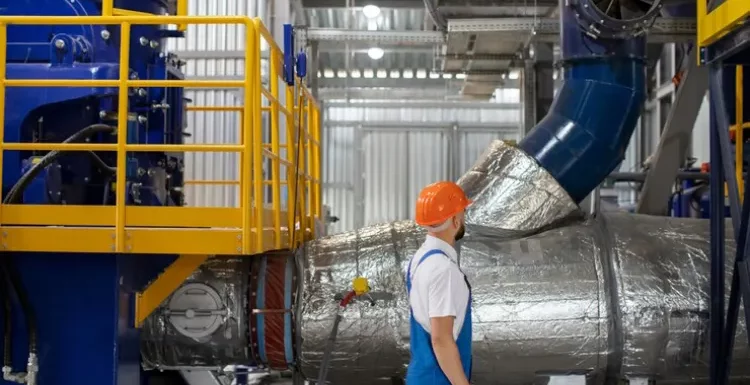
Understanding Heat Transfer Fundamentals
To optimize heat exchanger design, a comprehensive understanding of heat transfer fundamentals is essential. This encompasses knowledge of conduction, convection, and radiation mechanisms, as well as the thermophysical properties of the fluids involved. By grasping these principles, engineers can tailor exchanger configurations to maximize heat transfer efficiency across diverse operating conditions and applications.
Selecting Appropriate Heat Exchanger Types
The selection of appropriate heat exchanger types plays a pivotal role in achieving efficient heat transfer.
Whether considering shell-and-tube, plate, finned-tube, or other configurations, the suitability of each type should align with the specific heat transfer requirements, fluid properties, space limitations, and operational constraints.
Careful consideration of these factors ensures optimal heat exchange performance and system integration.
Optimizing Fluid Flow and Velocity
Efficient heat transfer hinges on the optimization of fluid flow and velocity within the exchanger system. Balancing flow rates, minimizing pressure drops, and optimizing fluid velocities facilitate enhanced heat transfer coefficients, reducing thermal resistance and promoting efficient energy transfer. By fine-tuning fluid dynamics, engineers can elevate exchanger performance while maintaining operational stability.
Enhancing Heat Transfer Surface Area
Maximizing heat transfer surface area is a key strategy for improving heat exchanger efficiency. This can be achieved through innovative geometric designs, enhancing surface textures, introducing extended surfaces, or incorporating advanced materials with superior thermal conductivity. Expanding the available surface area enables greater heat exchange capacity, elevating the overall efficiency of the exchanger system.
Implementing Automated Part Inspection Systems
The integration of automated part inspection systems within heat exchanger manufacturing can significantly bolster efficiency and reliability. These advanced systems can perform non-destructive evaluations, detecting flaws or inconsistencies in exchanger components that may affect performance.
By ensuring each part meets stringent quality standards, automated inspection systems can mitigate the risk of failure and enhance the overall safety of the heat exchange system.
Furthermore, the data collected by these systems enables continuous improvement in design and fabrication processes, fostering a cycle of better performance, longer service life, and reduced maintenance requirements.
Employing Advanced Heat Transfer Enhancements
The utilization of advanced heat transfer enhancements, such as turbulators, vortex generators, and surface treatments, can significantly augment heat exchanger performance. These enhancements disrupt boundary layers, intensify convective heat transfer, and mitigate fouling issues, thereby bolstering the overall heat transfer coefficient and optimizing thermal energy exchange within the exchanger.
Implementing Optimal Thermal Insulation
The implementation of optimal thermal insulation is crucial for minimizing heat losses and optimizing energy efficiency within heat exchanger systems. By selecting high-performance insulation materials, mitigating thermal bridging, and addressing potential insulation degradation factors, engineers can preserve thermal integrity, reduce energy consumption, and enhance the overall effectiveness of heat transfer processes.
Utilizing State-of-the-Art Computational Tools
Leveraging state-of-the-art computational tools and simulation software empowers engineers to conduct detailed heat transfer analyses, optimize exchanger designs, and predict system performance under varying operating conditions. Through virtual prototyping and simulation-driven design iterations, engineers can refine exchanger geometries, fluid flow patterns, and thermal characteristics to achieve superior heat transfer efficiency.
Integrating Intelligent Control and Monitoring Systems
Integrating intelligent control and monitoring systems into heat exchanger installations enables real-time performance optimization and energy management. By deploying sensors, actuators, and predictive algorithms, engineers can dynamically adjust operating parameters, maintain optimal thermal conditions, and proactively identify opportunities for further enhancing heat transfer efficiency based on real-time data insights.
Prioritizing Maintenance and Fouling Mitigation
Prioritizing proactive maintenance and fouling mitigation measures is essential for sustaining long-term heat exchanger performance. Regular inspection, cleaning protocols, and corrosion prevention strategies safeguard against fouling-related efficiency losses, ensuring consistent heat transfer performance and prolonging the operational lifespan of the exchanger system.
Conclusion
Efficient heat transfer is a cornerstone of energy-intensive industrial processes, HVAC systems, power generation, and thermal management applications.
By integrating the strategies outlined in this guide, engineers can meticulously optimize heat exchanger design, elevate heat transfer efficiency, and contribute to enhanced energy conservation, operational reliability, and cost-effective thermal management across diverse engineering domains.
